University Health and Social Care: Sociological Context Report
VerifiedAdded on 2021/05/31
|13
|3931
|50
Report
AI Summary
This report delves into the sociological context of health and social care, examining the influence of societal factors, cultural values, and social inequalities on health outcomes. It explores the political, economic, and social components of society, highlighting how these elements shape individual and group behaviors. The report analyzes the impact of societal changes, including technological advancements, political shifts, and globalization, on health and care. Furthermore, it investigates the effects of social inequalities, such as those related to education, poverty, and resource distribution, on health disparities and access to care. The analysis includes the application of sociological theories like structural functionalism and conflict theory to understand these complex relationships and the implications for public health policies and interventions. The report also highlights the influence of cultural values on health practices, life expectancy, and disease prevalence, emphasizing the need for culturally sensitive approaches in health and social care.
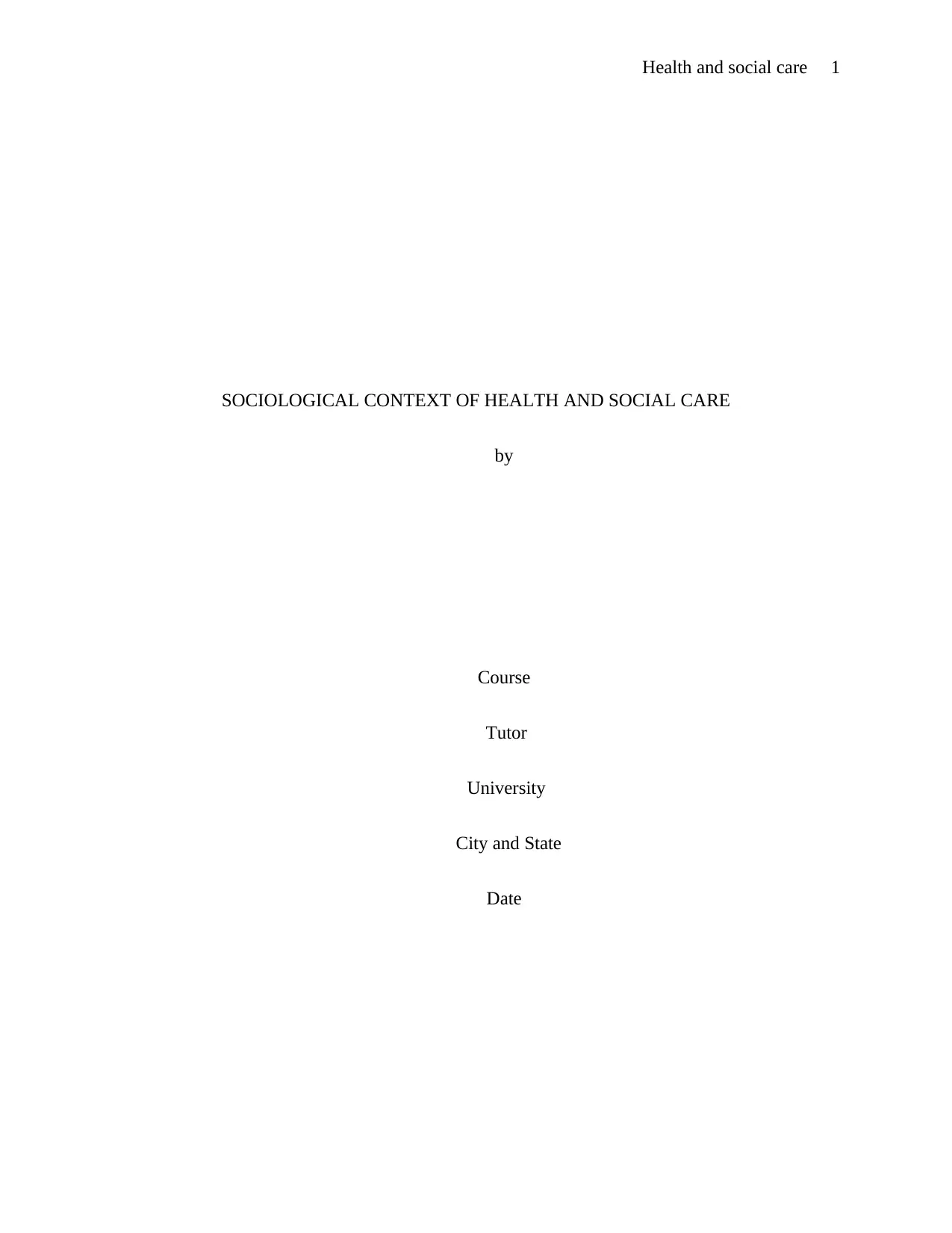
Health and social care 1
SOCIOLOGICAL CONTEXT OF HEALTH AND SOCIAL CARE
by
Course
Tutor
University
City and State
Date
SOCIOLOGICAL CONTEXT OF HEALTH AND SOCIAL CARE
by
Course
Tutor
University
City and State
Date
Paraphrase This Document
Need a fresh take? Get an instant paraphrase of this document with our AI Paraphraser
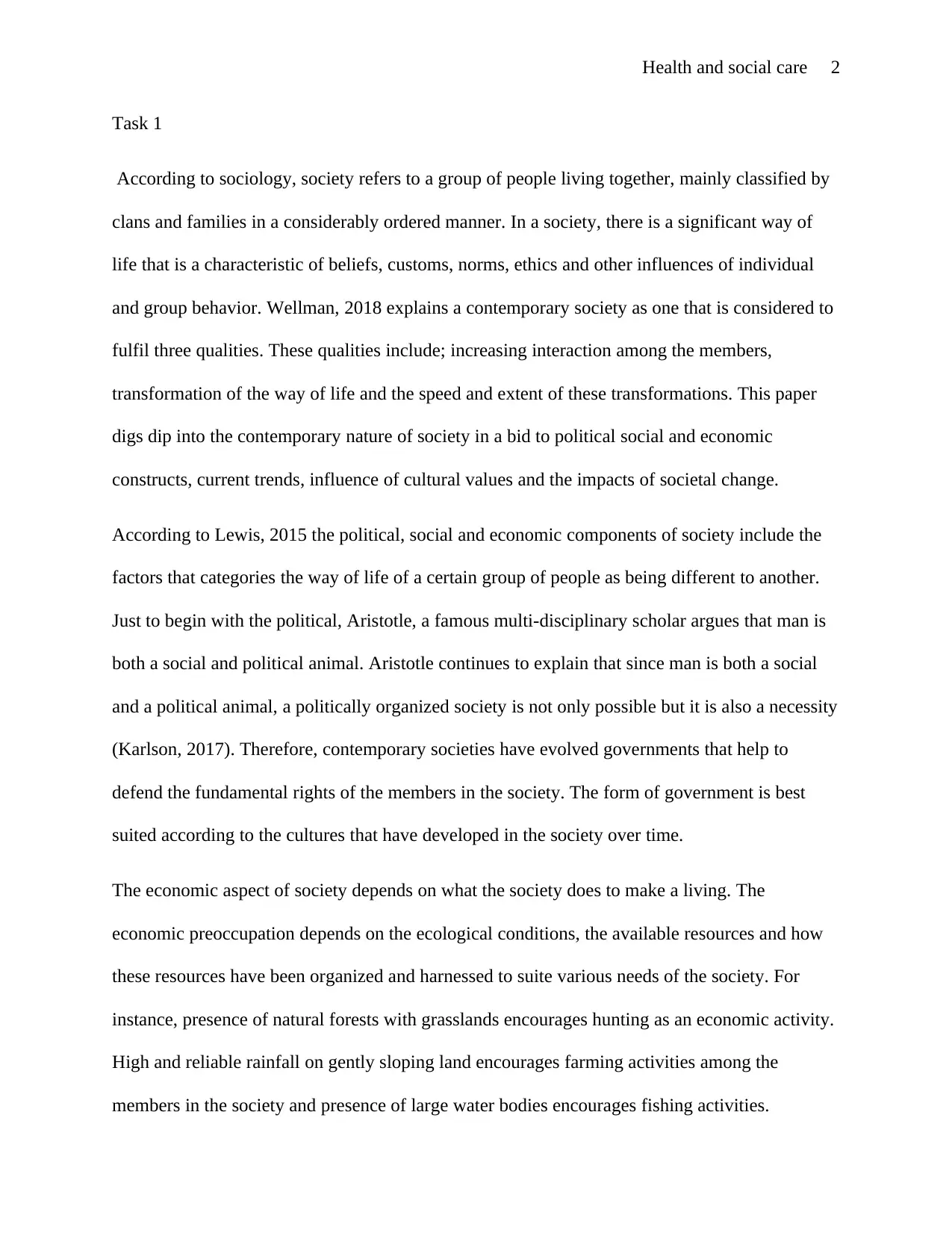
Health and social care 2
Task 1
According to sociology, society refers to a group of people living together, mainly classified by
clans and families in a considerably ordered manner. In a society, there is a significant way of
life that is a characteristic of beliefs, customs, norms, ethics and other influences of individual
and group behavior. Wellman, 2018 explains a contemporary society as one that is considered to
fulfil three qualities. These qualities include; increasing interaction among the members,
transformation of the way of life and the speed and extent of these transformations. This paper
digs dip into the contemporary nature of society in a bid to political social and economic
constructs, current trends, influence of cultural values and the impacts of societal change.
According to Lewis, 2015 the political, social and economic components of society include the
factors that categories the way of life of a certain group of people as being different to another.
Just to begin with the political, Aristotle, a famous multi-disciplinary scholar argues that man is
both a social and political animal. Aristotle continues to explain that since man is both a social
and a political animal, a politically organized society is not only possible but it is also a necessity
(Karlson, 2017). Therefore, contemporary societies have evolved governments that help to
defend the fundamental rights of the members in the society. The form of government is best
suited according to the cultures that have developed in the society over time.
The economic aspect of society depends on what the society does to make a living. The
economic preoccupation depends on the ecological conditions, the available resources and how
these resources have been organized and harnessed to suite various needs of the society. For
instance, presence of natural forests with grasslands encourages hunting as an economic activity.
High and reliable rainfall on gently sloping land encourages farming activities among the
members in the society and presence of large water bodies encourages fishing activities.
Task 1
According to sociology, society refers to a group of people living together, mainly classified by
clans and families in a considerably ordered manner. In a society, there is a significant way of
life that is a characteristic of beliefs, customs, norms, ethics and other influences of individual
and group behavior. Wellman, 2018 explains a contemporary society as one that is considered to
fulfil three qualities. These qualities include; increasing interaction among the members,
transformation of the way of life and the speed and extent of these transformations. This paper
digs dip into the contemporary nature of society in a bid to political social and economic
constructs, current trends, influence of cultural values and the impacts of societal change.
According to Lewis, 2015 the political, social and economic components of society include the
factors that categories the way of life of a certain group of people as being different to another.
Just to begin with the political, Aristotle, a famous multi-disciplinary scholar argues that man is
both a social and political animal. Aristotle continues to explain that since man is both a social
and a political animal, a politically organized society is not only possible but it is also a necessity
(Karlson, 2017). Therefore, contemporary societies have evolved governments that help to
defend the fundamental rights of the members in the society. The form of government is best
suited according to the cultures that have developed in the society over time.
The economic aspect of society depends on what the society does to make a living. The
economic preoccupation depends on the ecological conditions, the available resources and how
these resources have been organized and harnessed to suite various needs of the society. For
instance, presence of natural forests with grasslands encourages hunting as an economic activity.
High and reliable rainfall on gently sloping land encourages farming activities among the
members in the society and presence of large water bodies encourages fishing activities.
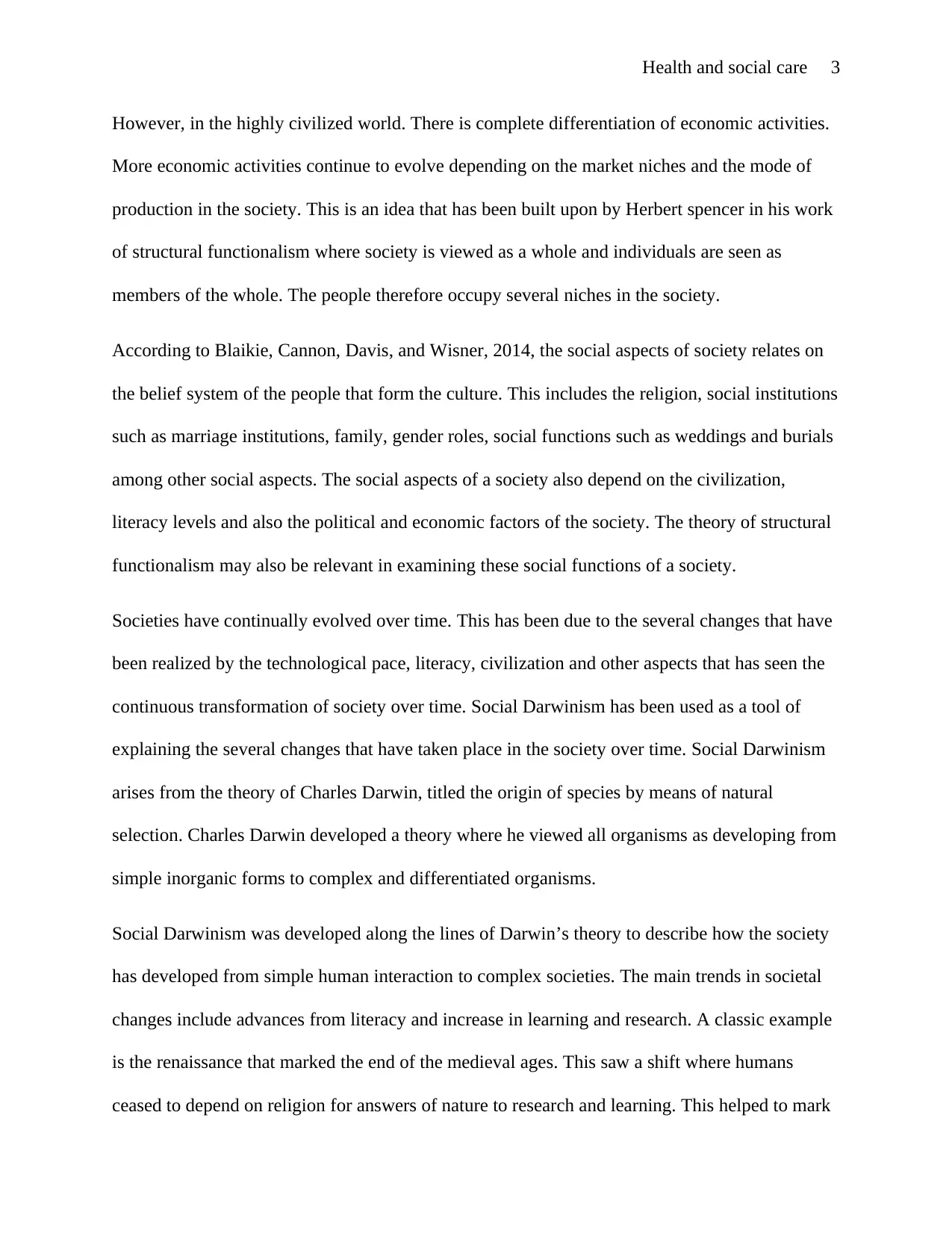
Health and social care 3
However, in the highly civilized world. There is complete differentiation of economic activities.
More economic activities continue to evolve depending on the market niches and the mode of
production in the society. This is an idea that has been built upon by Herbert spencer in his work
of structural functionalism where society is viewed as a whole and individuals are seen as
members of the whole. The people therefore occupy several niches in the society.
According to Blaikie, Cannon, Davis, and Wisner, 2014, the social aspects of society relates on
the belief system of the people that form the culture. This includes the religion, social institutions
such as marriage institutions, family, gender roles, social functions such as weddings and burials
among other social aspects. The social aspects of a society also depend on the civilization,
literacy levels and also the political and economic factors of the society. The theory of structural
functionalism may also be relevant in examining these social functions of a society.
Societies have continually evolved over time. This has been due to the several changes that have
been realized by the technological pace, literacy, civilization and other aspects that has seen the
continuous transformation of society over time. Social Darwinism has been used as a tool of
explaining the several changes that have taken place in the society over time. Social Darwinism
arises from the theory of Charles Darwin, titled the origin of species by means of natural
selection. Charles Darwin developed a theory where he viewed all organisms as developing from
simple inorganic forms to complex and differentiated organisms.
Social Darwinism was developed along the lines of Darwin’s theory to describe how the society
has developed from simple human interaction to complex societies. The main trends in societal
changes include advances from literacy and increase in learning and research. A classic example
is the renaissance that marked the end of the medieval ages. This saw a shift where humans
ceased to depend on religion for answers of nature to research and learning. This helped to mark
However, in the highly civilized world. There is complete differentiation of economic activities.
More economic activities continue to evolve depending on the market niches and the mode of
production in the society. This is an idea that has been built upon by Herbert spencer in his work
of structural functionalism where society is viewed as a whole and individuals are seen as
members of the whole. The people therefore occupy several niches in the society.
According to Blaikie, Cannon, Davis, and Wisner, 2014, the social aspects of society relates on
the belief system of the people that form the culture. This includes the religion, social institutions
such as marriage institutions, family, gender roles, social functions such as weddings and burials
among other social aspects. The social aspects of a society also depend on the civilization,
literacy levels and also the political and economic factors of the society. The theory of structural
functionalism may also be relevant in examining these social functions of a society.
Societies have continually evolved over time. This has been due to the several changes that have
been realized by the technological pace, literacy, civilization and other aspects that has seen the
continuous transformation of society over time. Social Darwinism has been used as a tool of
explaining the several changes that have taken place in the society over time. Social Darwinism
arises from the theory of Charles Darwin, titled the origin of species by means of natural
selection. Charles Darwin developed a theory where he viewed all organisms as developing from
simple inorganic forms to complex and differentiated organisms.
Social Darwinism was developed along the lines of Darwin’s theory to describe how the society
has developed from simple human interaction to complex societies. The main trends in societal
changes include advances from literacy and increase in learning and research. A classic example
is the renaissance that marked the end of the medieval ages. This saw a shift where humans
ceased to depend on religion for answers of nature to research and learning. This helped to mark
⊘ This is a preview!⊘
Do you want full access?
Subscribe today to unlock all pages.

Trusted by 1+ million students worldwide
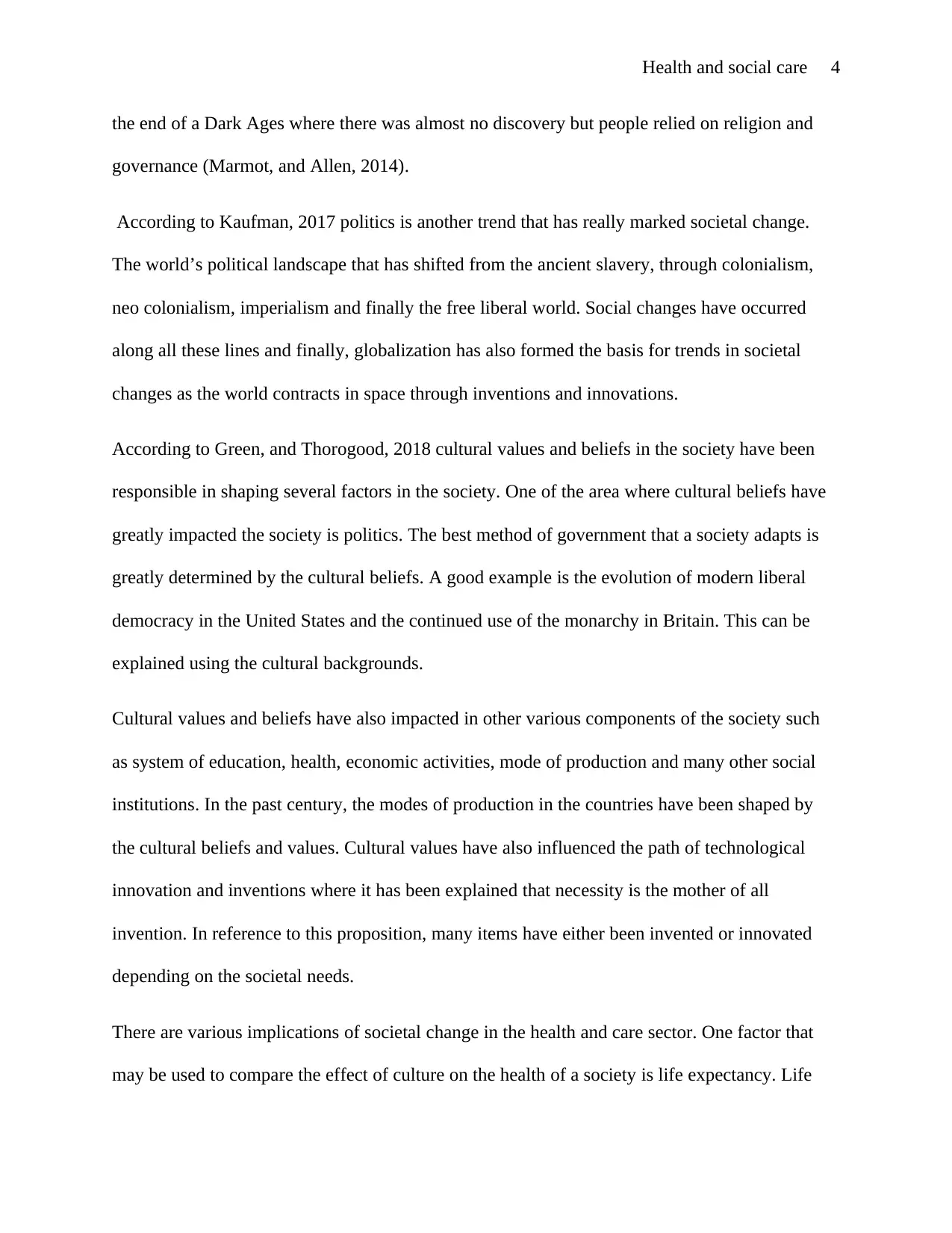
Health and social care 4
the end of a Dark Ages where there was almost no discovery but people relied on religion and
governance (Marmot, and Allen, 2014).
According to Kaufman, 2017 politics is another trend that has really marked societal change.
The world’s political landscape that has shifted from the ancient slavery, through colonialism,
neo colonialism, imperialism and finally the free liberal world. Social changes have occurred
along all these lines and finally, globalization has also formed the basis for trends in societal
changes as the world contracts in space through inventions and innovations.
According to Green, and Thorogood, 2018 cultural values and beliefs in the society have been
responsible in shaping several factors in the society. One of the area where cultural beliefs have
greatly impacted the society is politics. The best method of government that a society adapts is
greatly determined by the cultural beliefs. A good example is the evolution of modern liberal
democracy in the United States and the continued use of the monarchy in Britain. This can be
explained using the cultural backgrounds.
Cultural values and beliefs have also impacted in other various components of the society such
as system of education, health, economic activities, mode of production and many other social
institutions. In the past century, the modes of production in the countries have been shaped by
the cultural beliefs and values. Cultural values have also influenced the path of technological
innovation and inventions where it has been explained that necessity is the mother of all
invention. In reference to this proposition, many items have either been invented or innovated
depending on the societal needs.
There are various implications of societal change in the health and care sector. One factor that
may be used to compare the effect of culture on the health of a society is life expectancy. Life
the end of a Dark Ages where there was almost no discovery but people relied on religion and
governance (Marmot, and Allen, 2014).
According to Kaufman, 2017 politics is another trend that has really marked societal change.
The world’s political landscape that has shifted from the ancient slavery, through colonialism,
neo colonialism, imperialism and finally the free liberal world. Social changes have occurred
along all these lines and finally, globalization has also formed the basis for trends in societal
changes as the world contracts in space through inventions and innovations.
According to Green, and Thorogood, 2018 cultural values and beliefs in the society have been
responsible in shaping several factors in the society. One of the area where cultural beliefs have
greatly impacted the society is politics. The best method of government that a society adapts is
greatly determined by the cultural beliefs. A good example is the evolution of modern liberal
democracy in the United States and the continued use of the monarchy in Britain. This can be
explained using the cultural backgrounds.
Cultural values and beliefs have also impacted in other various components of the society such
as system of education, health, economic activities, mode of production and many other social
institutions. In the past century, the modes of production in the countries have been shaped by
the cultural beliefs and values. Cultural values have also influenced the path of technological
innovation and inventions where it has been explained that necessity is the mother of all
invention. In reference to this proposition, many items have either been invented or innovated
depending on the societal needs.
There are various implications of societal change in the health and care sector. One factor that
may be used to compare the effect of culture on the health of a society is life expectancy. Life
Paraphrase This Document
Need a fresh take? Get an instant paraphrase of this document with our AI Paraphraser

Health and social care 5
expectancy varies greatly depending on the culture of different people. For instance, Japan and
India are countries in the same Asian continent but with different cultures. Remarkably Japan has
a life expectancy of 81.9 while India has a life expectancy of around 63 years a difference of
almost 20 years. Other factors that may be used to determine the implication of culture on health
include the mortality, disease prevalence and also epidemiology (Clouston, Rubin, Phelan, and
Link, 2016).
For instance, cultural values and beliefs have influenced the definition of health. How a society
defines heath determines how and when the society seeks medical attention. It also influences the
path of treatment that a society may opt to use. Baldwin, 2016 argues that cultural values may
also influence other socially unacceptable factors such as stigma. Other cultural practices and
beliefs may either predispose a society to infection or health safety. A good example is the
traditional circumcision practices that have been known to predispose people to various infection
such as HIV/ AIDS.
Task 2
Social inequality is a phenomenon in sociology that is characterized with unequal distribution of
resources. Unequal distribution of resources develops from differences in race, religion, social
economic status, class, education and literacy, employment and other social quantifiers of society
argues Williams, Priest, and Anderson, 2016. The inequality may also develop from
governmental influences or environmental influences. Social inequalities have had several
influences in the health of a society. This paper explains why these inequalities exist, an analysis
of the inequalities and how these inequalities have impacted in the arena of health services.
expectancy varies greatly depending on the culture of different people. For instance, Japan and
India are countries in the same Asian continent but with different cultures. Remarkably Japan has
a life expectancy of 81.9 while India has a life expectancy of around 63 years a difference of
almost 20 years. Other factors that may be used to determine the implication of culture on health
include the mortality, disease prevalence and also epidemiology (Clouston, Rubin, Phelan, and
Link, 2016).
For instance, cultural values and beliefs have influenced the definition of health. How a society
defines heath determines how and when the society seeks medical attention. It also influences the
path of treatment that a society may opt to use. Baldwin, 2016 argues that cultural values may
also influence other socially unacceptable factors such as stigma. Other cultural practices and
beliefs may either predispose a society to infection or health safety. A good example is the
traditional circumcision practices that have been known to predispose people to various infection
such as HIV/ AIDS.
Task 2
Social inequality is a phenomenon in sociology that is characterized with unequal distribution of
resources. Unequal distribution of resources develops from differences in race, religion, social
economic status, class, education and literacy, employment and other social quantifiers of society
argues Williams, Priest, and Anderson, 2016. The inequality may also develop from
governmental influences or environmental influences. Social inequalities have had several
influences in the health of a society. This paper explains why these inequalities exist, an analysis
of the inequalities and how these inequalities have impacted in the arena of health services.
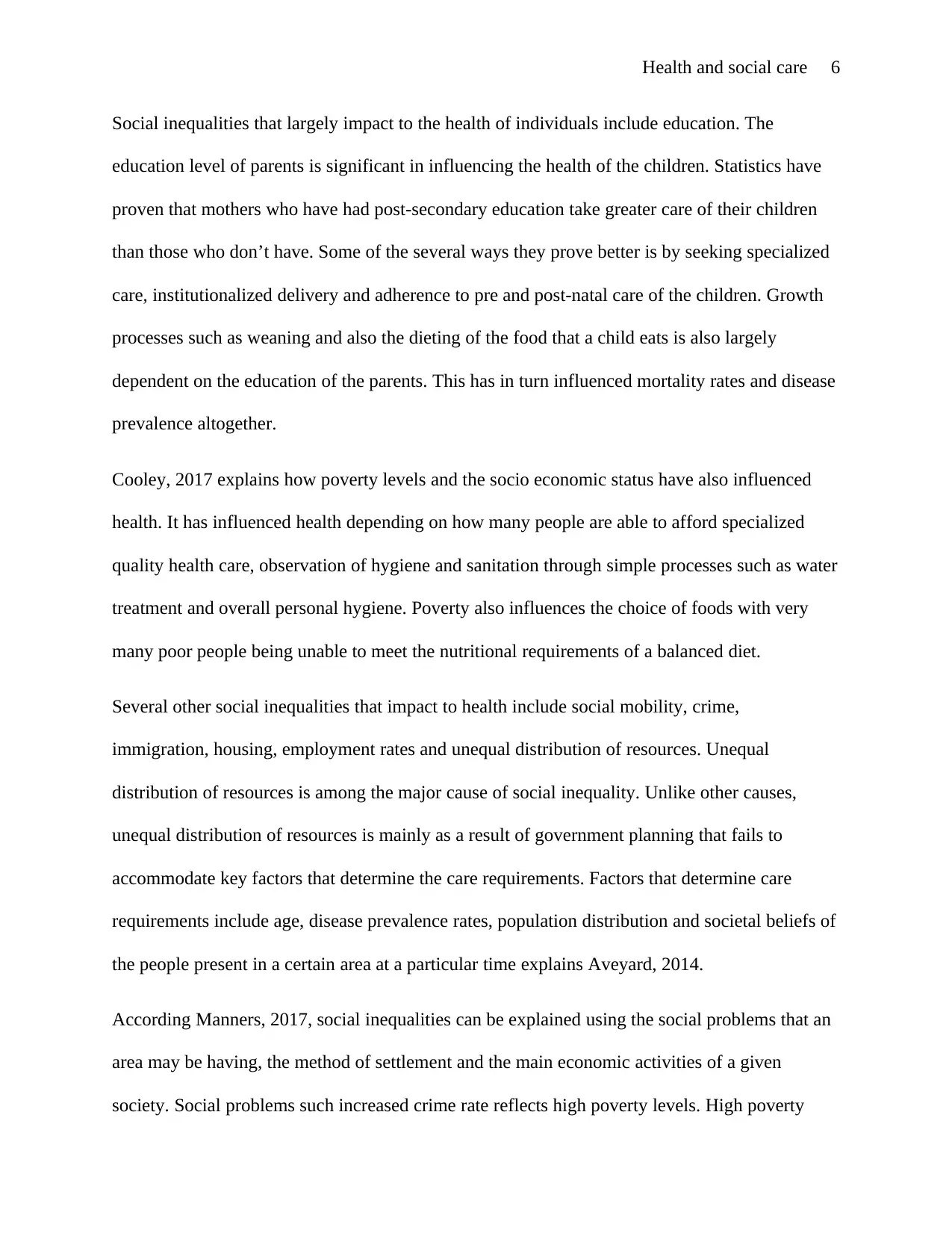
Health and social care 6
Social inequalities that largely impact to the health of individuals include education. The
education level of parents is significant in influencing the health of the children. Statistics have
proven that mothers who have had post-secondary education take greater care of their children
than those who don’t have. Some of the several ways they prove better is by seeking specialized
care, institutionalized delivery and adherence to pre and post-natal care of the children. Growth
processes such as weaning and also the dieting of the food that a child eats is also largely
dependent on the education of the parents. This has in turn influenced mortality rates and disease
prevalence altogether.
Cooley, 2017 explains how poverty levels and the socio economic status have also influenced
health. It has influenced health depending on how many people are able to afford specialized
quality health care, observation of hygiene and sanitation through simple processes such as water
treatment and overall personal hygiene. Poverty also influences the choice of foods with very
many poor people being unable to meet the nutritional requirements of a balanced diet.
Several other social inequalities that impact to health include social mobility, crime,
immigration, housing, employment rates and unequal distribution of resources. Unequal
distribution of resources is among the major cause of social inequality. Unlike other causes,
unequal distribution of resources is mainly as a result of government planning that fails to
accommodate key factors that determine the care requirements. Factors that determine care
requirements include age, disease prevalence rates, population distribution and societal beliefs of
the people present in a certain area at a particular time explains Aveyard, 2014.
According Manners, 2017, social inequalities can be explained using the social problems that an
area may be having, the method of settlement and the main economic activities of a given
society. Social problems such increased crime rate reflects high poverty levels. High poverty
Social inequalities that largely impact to the health of individuals include education. The
education level of parents is significant in influencing the health of the children. Statistics have
proven that mothers who have had post-secondary education take greater care of their children
than those who don’t have. Some of the several ways they prove better is by seeking specialized
care, institutionalized delivery and adherence to pre and post-natal care of the children. Growth
processes such as weaning and also the dieting of the food that a child eats is also largely
dependent on the education of the parents. This has in turn influenced mortality rates and disease
prevalence altogether.
Cooley, 2017 explains how poverty levels and the socio economic status have also influenced
health. It has influenced health depending on how many people are able to afford specialized
quality health care, observation of hygiene and sanitation through simple processes such as water
treatment and overall personal hygiene. Poverty also influences the choice of foods with very
many poor people being unable to meet the nutritional requirements of a balanced diet.
Several other social inequalities that impact to health include social mobility, crime,
immigration, housing, employment rates and unequal distribution of resources. Unequal
distribution of resources is among the major cause of social inequality. Unlike other causes,
unequal distribution of resources is mainly as a result of government planning that fails to
accommodate key factors that determine the care requirements. Factors that determine care
requirements include age, disease prevalence rates, population distribution and societal beliefs of
the people present in a certain area at a particular time explains Aveyard, 2014.
According Manners, 2017, social inequalities can be explained using the social problems that an
area may be having, the method of settlement and the main economic activities of a given
society. Social problems such increased crime rate reflects high poverty levels. High poverty
⊘ This is a preview!⊘
Do you want full access?
Subscribe today to unlock all pages.

Trusted by 1+ million students worldwide
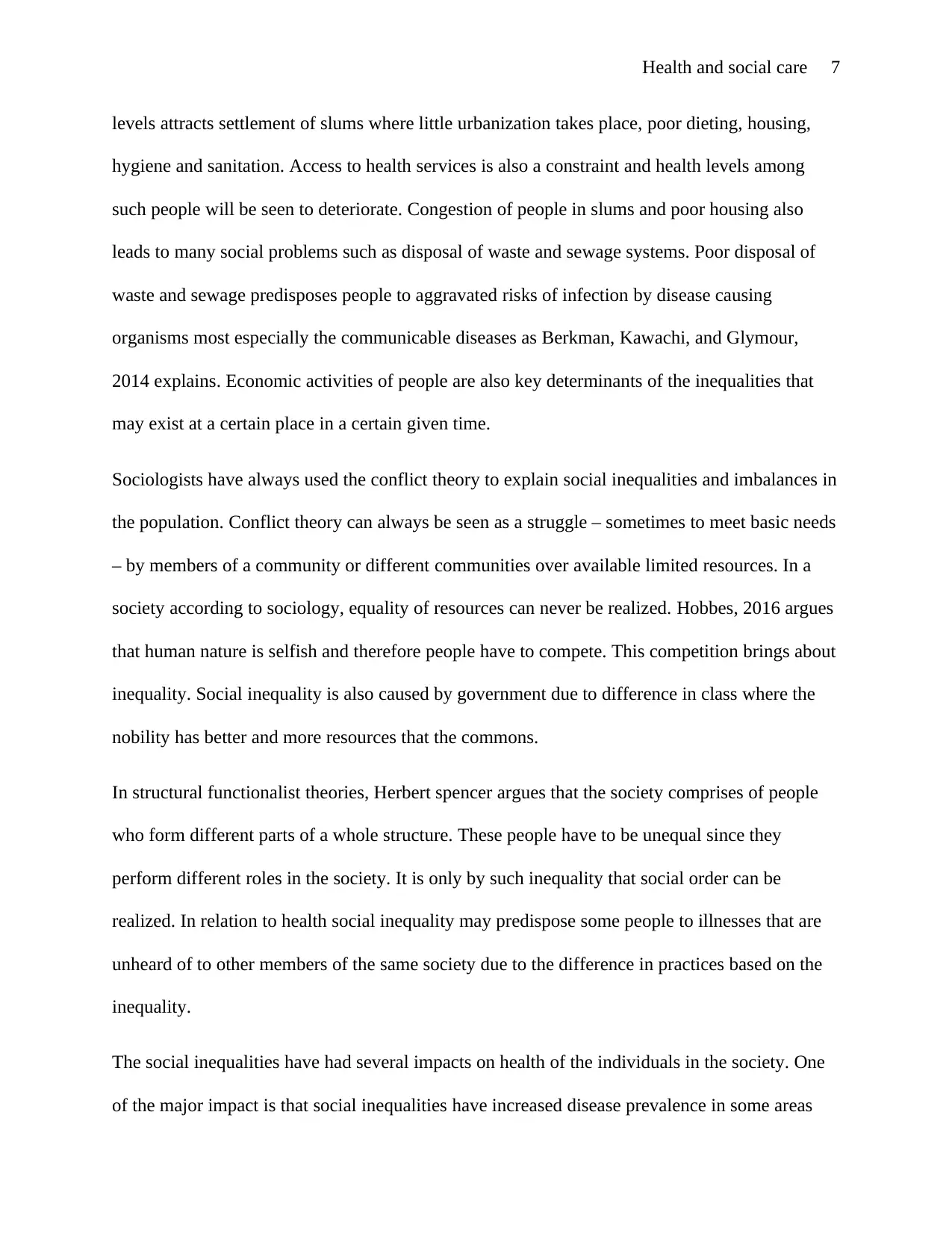
Health and social care 7
levels attracts settlement of slums where little urbanization takes place, poor dieting, housing,
hygiene and sanitation. Access to health services is also a constraint and health levels among
such people will be seen to deteriorate. Congestion of people in slums and poor housing also
leads to many social problems such as disposal of waste and sewage systems. Poor disposal of
waste and sewage predisposes people to aggravated risks of infection by disease causing
organisms most especially the communicable diseases as Berkman, Kawachi, and Glymour,
2014 explains. Economic activities of people are also key determinants of the inequalities that
may exist at a certain place in a certain given time.
Sociologists have always used the conflict theory to explain social inequalities and imbalances in
the population. Conflict theory can always be seen as a struggle – sometimes to meet basic needs
– by members of a community or different communities over available limited resources. In a
society according to sociology, equality of resources can never be realized. Hobbes, 2016 argues
that human nature is selfish and therefore people have to compete. This competition brings about
inequality. Social inequality is also caused by government due to difference in class where the
nobility has better and more resources that the commons.
In structural functionalist theories, Herbert spencer argues that the society comprises of people
who form different parts of a whole structure. These people have to be unequal since they
perform different roles in the society. It is only by such inequality that social order can be
realized. In relation to health social inequality may predispose some people to illnesses that are
unheard of to other members of the same society due to the difference in practices based on the
inequality.
The social inequalities have had several impacts on health of the individuals in the society. One
of the major impact is that social inequalities have increased disease prevalence in some areas
levels attracts settlement of slums where little urbanization takes place, poor dieting, housing,
hygiene and sanitation. Access to health services is also a constraint and health levels among
such people will be seen to deteriorate. Congestion of people in slums and poor housing also
leads to many social problems such as disposal of waste and sewage systems. Poor disposal of
waste and sewage predisposes people to aggravated risks of infection by disease causing
organisms most especially the communicable diseases as Berkman, Kawachi, and Glymour,
2014 explains. Economic activities of people are also key determinants of the inequalities that
may exist at a certain place in a certain given time.
Sociologists have always used the conflict theory to explain social inequalities and imbalances in
the population. Conflict theory can always be seen as a struggle – sometimes to meet basic needs
– by members of a community or different communities over available limited resources. In a
society according to sociology, equality of resources can never be realized. Hobbes, 2016 argues
that human nature is selfish and therefore people have to compete. This competition brings about
inequality. Social inequality is also caused by government due to difference in class where the
nobility has better and more resources that the commons.
In structural functionalist theories, Herbert spencer argues that the society comprises of people
who form different parts of a whole structure. These people have to be unequal since they
perform different roles in the society. It is only by such inequality that social order can be
realized. In relation to health social inequality may predispose some people to illnesses that are
unheard of to other members of the same society due to the difference in practices based on the
inequality.
The social inequalities have had several impacts on health of the individuals in the society. One
of the major impact is that social inequalities have increased disease prevalence in some areas
Paraphrase This Document
Need a fresh take? Get an instant paraphrase of this document with our AI Paraphraser
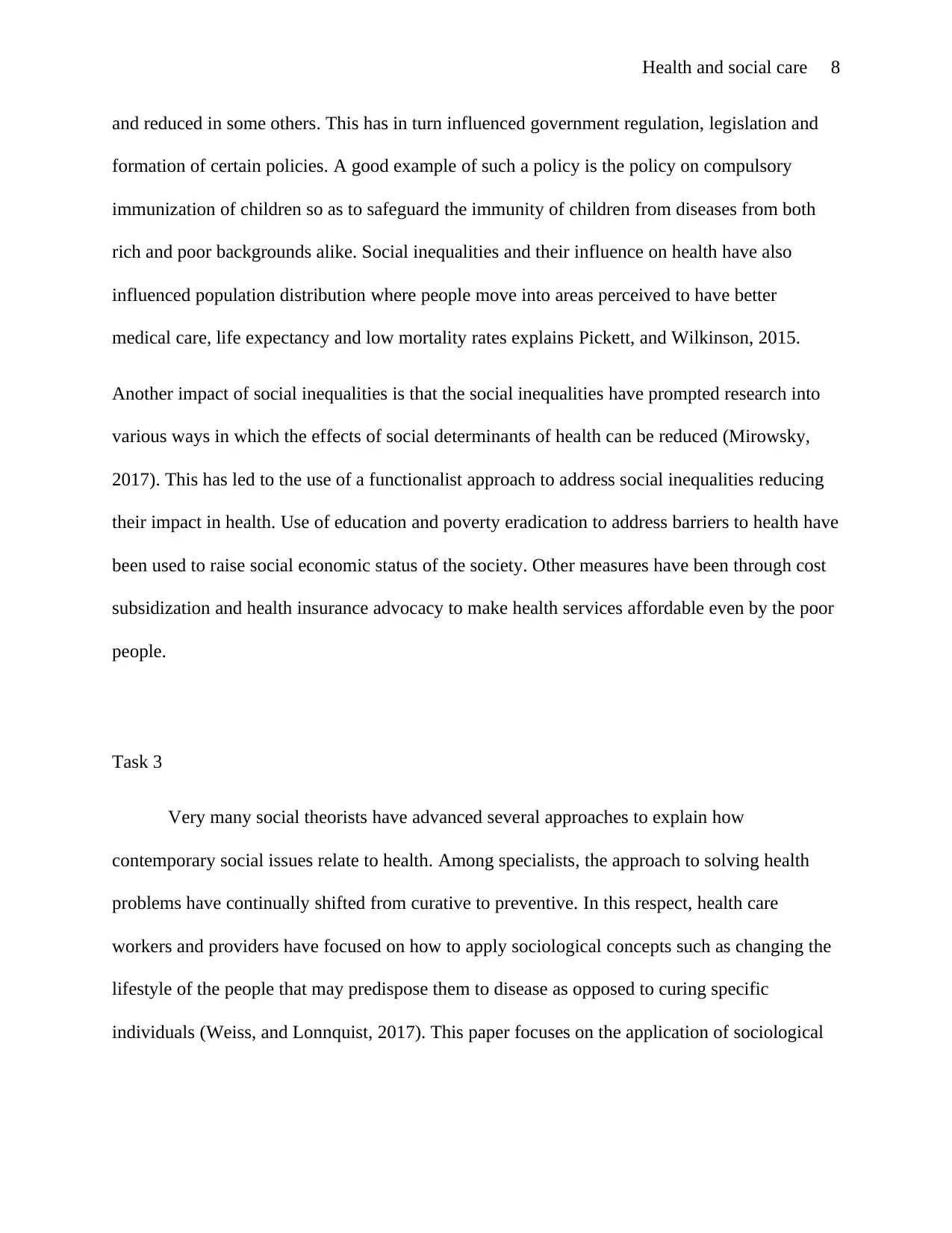
Health and social care 8
and reduced in some others. This has in turn influenced government regulation, legislation and
formation of certain policies. A good example of such a policy is the policy on compulsory
immunization of children so as to safeguard the immunity of children from diseases from both
rich and poor backgrounds alike. Social inequalities and their influence on health have also
influenced population distribution where people move into areas perceived to have better
medical care, life expectancy and low mortality rates explains Pickett, and Wilkinson, 2015.
Another impact of social inequalities is that the social inequalities have prompted research into
various ways in which the effects of social determinants of health can be reduced (Mirowsky,
2017). This has led to the use of a functionalist approach to address social inequalities reducing
their impact in health. Use of education and poverty eradication to address barriers to health have
been used to raise social economic status of the society. Other measures have been through cost
subsidization and health insurance advocacy to make health services affordable even by the poor
people.
Task 3
Very many social theorists have advanced several approaches to explain how
contemporary social issues relate to health. Among specialists, the approach to solving health
problems have continually shifted from curative to preventive. In this respect, health care
workers and providers have focused on how to apply sociological concepts such as changing the
lifestyle of the people that may predispose them to disease as opposed to curing specific
individuals (Weiss, and Lonnquist, 2017). This paper focuses on the application of sociological
and reduced in some others. This has in turn influenced government regulation, legislation and
formation of certain policies. A good example of such a policy is the policy on compulsory
immunization of children so as to safeguard the immunity of children from diseases from both
rich and poor backgrounds alike. Social inequalities and their influence on health have also
influenced population distribution where people move into areas perceived to have better
medical care, life expectancy and low mortality rates explains Pickett, and Wilkinson, 2015.
Another impact of social inequalities is that the social inequalities have prompted research into
various ways in which the effects of social determinants of health can be reduced (Mirowsky,
2017). This has led to the use of a functionalist approach to address social inequalities reducing
their impact in health. Use of education and poverty eradication to address barriers to health have
been used to raise social economic status of the society. Other measures have been through cost
subsidization and health insurance advocacy to make health services affordable even by the poor
people.
Task 3
Very many social theorists have advanced several approaches to explain how
contemporary social issues relate to health. Among specialists, the approach to solving health
problems have continually shifted from curative to preventive. In this respect, health care
workers and providers have focused on how to apply sociological concepts such as changing the
lifestyle of the people that may predispose them to disease as opposed to curing specific
individuals (Weiss, and Lonnquist, 2017). This paper focuses on the application of sociological
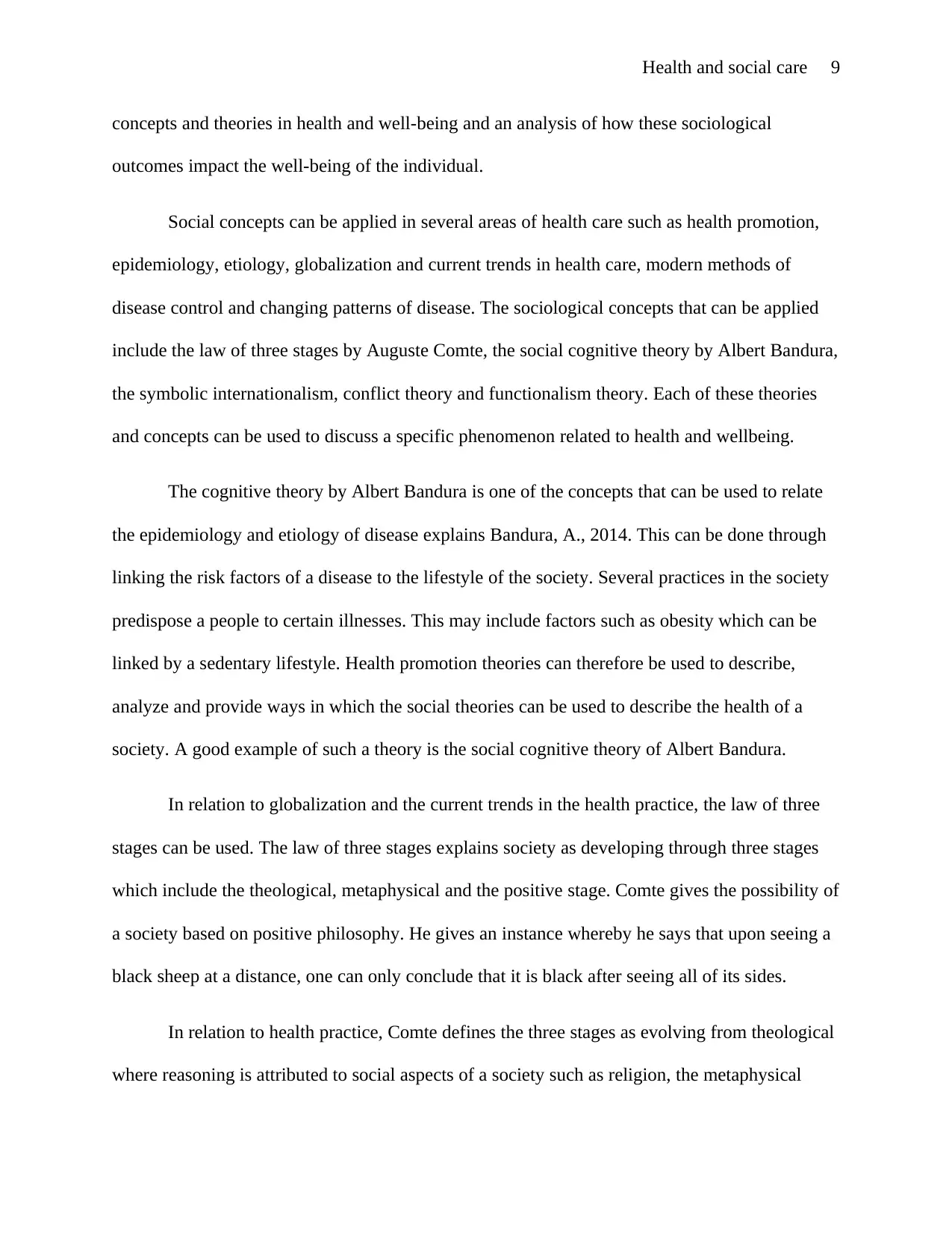
Health and social care 9
concepts and theories in health and well-being and an analysis of how these sociological
outcomes impact the well-being of the individual.
Social concepts can be applied in several areas of health care such as health promotion,
epidemiology, etiology, globalization and current trends in health care, modern methods of
disease control and changing patterns of disease. The sociological concepts that can be applied
include the law of three stages by Auguste Comte, the social cognitive theory by Albert Bandura,
the symbolic internationalism, conflict theory and functionalism theory. Each of these theories
and concepts can be used to discuss a specific phenomenon related to health and wellbeing.
The cognitive theory by Albert Bandura is one of the concepts that can be used to relate
the epidemiology and etiology of disease explains Bandura, A., 2014. This can be done through
linking the risk factors of a disease to the lifestyle of the society. Several practices in the society
predispose a people to certain illnesses. This may include factors such as obesity which can be
linked by a sedentary lifestyle. Health promotion theories can therefore be used to describe,
analyze and provide ways in which the social theories can be used to describe the health of a
society. A good example of such a theory is the social cognitive theory of Albert Bandura.
In relation to globalization and the current trends in the health practice, the law of three
stages can be used. The law of three stages explains society as developing through three stages
which include the theological, metaphysical and the positive stage. Comte gives the possibility of
a society based on positive philosophy. He gives an instance whereby he says that upon seeing a
black sheep at a distance, one can only conclude that it is black after seeing all of its sides.
In relation to health practice, Comte defines the three stages as evolving from theological
where reasoning is attributed to social aspects of a society such as religion, the metaphysical
concepts and theories in health and well-being and an analysis of how these sociological
outcomes impact the well-being of the individual.
Social concepts can be applied in several areas of health care such as health promotion,
epidemiology, etiology, globalization and current trends in health care, modern methods of
disease control and changing patterns of disease. The sociological concepts that can be applied
include the law of three stages by Auguste Comte, the social cognitive theory by Albert Bandura,
the symbolic internationalism, conflict theory and functionalism theory. Each of these theories
and concepts can be used to discuss a specific phenomenon related to health and wellbeing.
The cognitive theory by Albert Bandura is one of the concepts that can be used to relate
the epidemiology and etiology of disease explains Bandura, A., 2014. This can be done through
linking the risk factors of a disease to the lifestyle of the society. Several practices in the society
predispose a people to certain illnesses. This may include factors such as obesity which can be
linked by a sedentary lifestyle. Health promotion theories can therefore be used to describe,
analyze and provide ways in which the social theories can be used to describe the health of a
society. A good example of such a theory is the social cognitive theory of Albert Bandura.
In relation to globalization and the current trends in the health practice, the law of three
stages can be used. The law of three stages explains society as developing through three stages
which include the theological, metaphysical and the positive stage. Comte gives the possibility of
a society based on positive philosophy. He gives an instance whereby he says that upon seeing a
black sheep at a distance, one can only conclude that it is black after seeing all of its sides.
In relation to health practice, Comte defines the three stages as evolving from theological
where reasoning is attributed to social aspects of a society such as religion, the metaphysical
⊘ This is a preview!⊘
Do you want full access?
Subscribe today to unlock all pages.

Trusted by 1+ million students worldwide
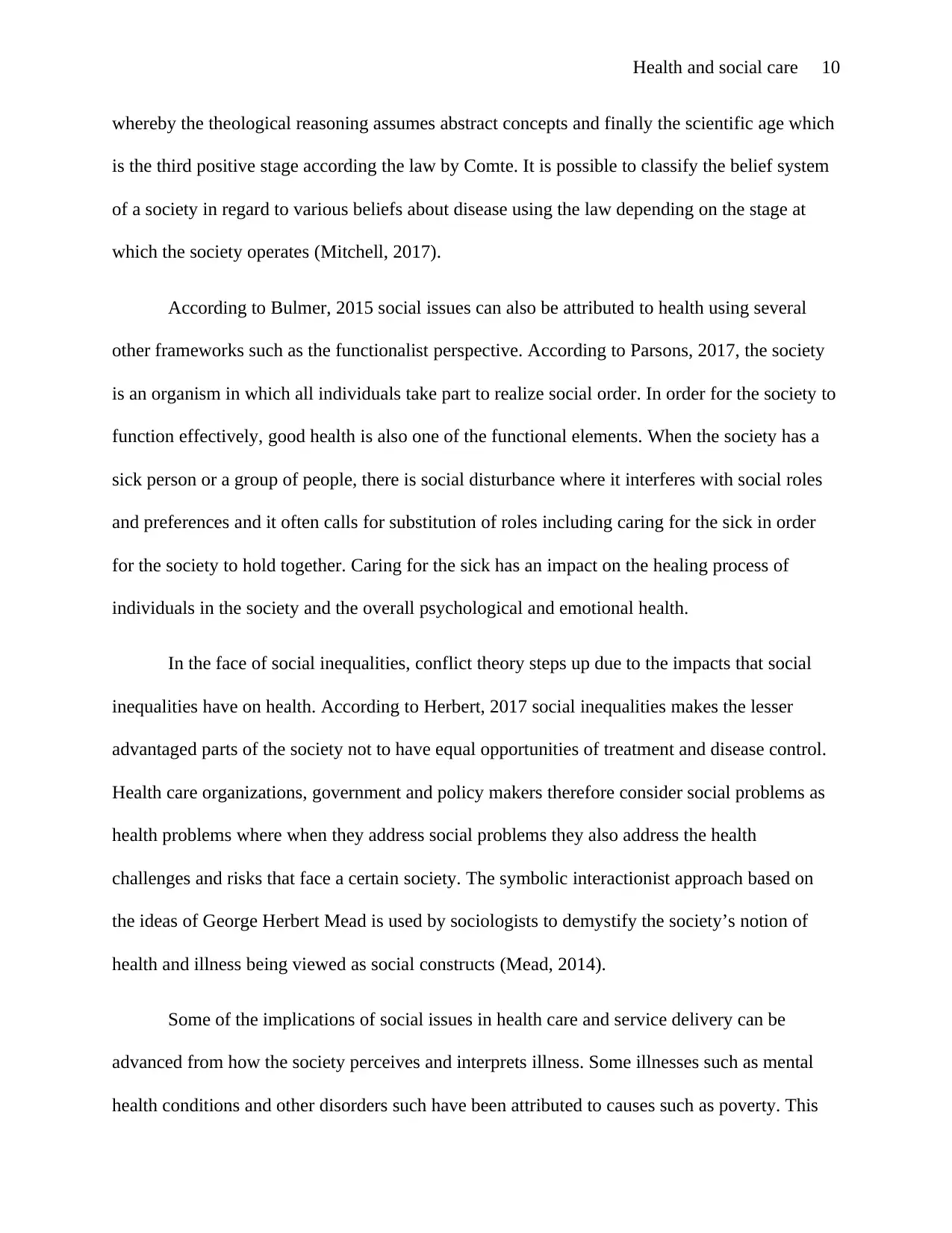
Health and social care 10
whereby the theological reasoning assumes abstract concepts and finally the scientific age which
is the third positive stage according the law by Comte. It is possible to classify the belief system
of a society in regard to various beliefs about disease using the law depending on the stage at
which the society operates (Mitchell, 2017).
According to Bulmer, 2015 social issues can also be attributed to health using several
other frameworks such as the functionalist perspective. According to Parsons, 2017, the society
is an organism in which all individuals take part to realize social order. In order for the society to
function effectively, good health is also one of the functional elements. When the society has a
sick person or a group of people, there is social disturbance where it interferes with social roles
and preferences and it often calls for substitution of roles including caring for the sick in order
for the society to hold together. Caring for the sick has an impact on the healing process of
individuals in the society and the overall psychological and emotional health.
In the face of social inequalities, conflict theory steps up due to the impacts that social
inequalities have on health. According to Herbert, 2017 social inequalities makes the lesser
advantaged parts of the society not to have equal opportunities of treatment and disease control.
Health care organizations, government and policy makers therefore consider social problems as
health problems where when they address social problems they also address the health
challenges and risks that face a certain society. The symbolic interactionist approach based on
the ideas of George Herbert Mead is used by sociologists to demystify the society’s notion of
health and illness being viewed as social constructs (Mead, 2014).
Some of the implications of social issues in health care and service delivery can be
advanced from how the society perceives and interprets illness. Some illnesses such as mental
health conditions and other disorders such have been attributed to causes such as poverty. This
whereby the theological reasoning assumes abstract concepts and finally the scientific age which
is the third positive stage according the law by Comte. It is possible to classify the belief system
of a society in regard to various beliefs about disease using the law depending on the stage at
which the society operates (Mitchell, 2017).
According to Bulmer, 2015 social issues can also be attributed to health using several
other frameworks such as the functionalist perspective. According to Parsons, 2017, the society
is an organism in which all individuals take part to realize social order. In order for the society to
function effectively, good health is also one of the functional elements. When the society has a
sick person or a group of people, there is social disturbance where it interferes with social roles
and preferences and it often calls for substitution of roles including caring for the sick in order
for the society to hold together. Caring for the sick has an impact on the healing process of
individuals in the society and the overall psychological and emotional health.
In the face of social inequalities, conflict theory steps up due to the impacts that social
inequalities have on health. According to Herbert, 2017 social inequalities makes the lesser
advantaged parts of the society not to have equal opportunities of treatment and disease control.
Health care organizations, government and policy makers therefore consider social problems as
health problems where when they address social problems they also address the health
challenges and risks that face a certain society. The symbolic interactionist approach based on
the ideas of George Herbert Mead is used by sociologists to demystify the society’s notion of
health and illness being viewed as social constructs (Mead, 2014).
Some of the implications of social issues in health care and service delivery can be
advanced from how the society perceives and interprets illness. Some illnesses such as mental
health conditions and other disorders such have been attributed to causes such as poverty. This
Paraphrase This Document
Need a fresh take? Get an instant paraphrase of this document with our AI Paraphraser
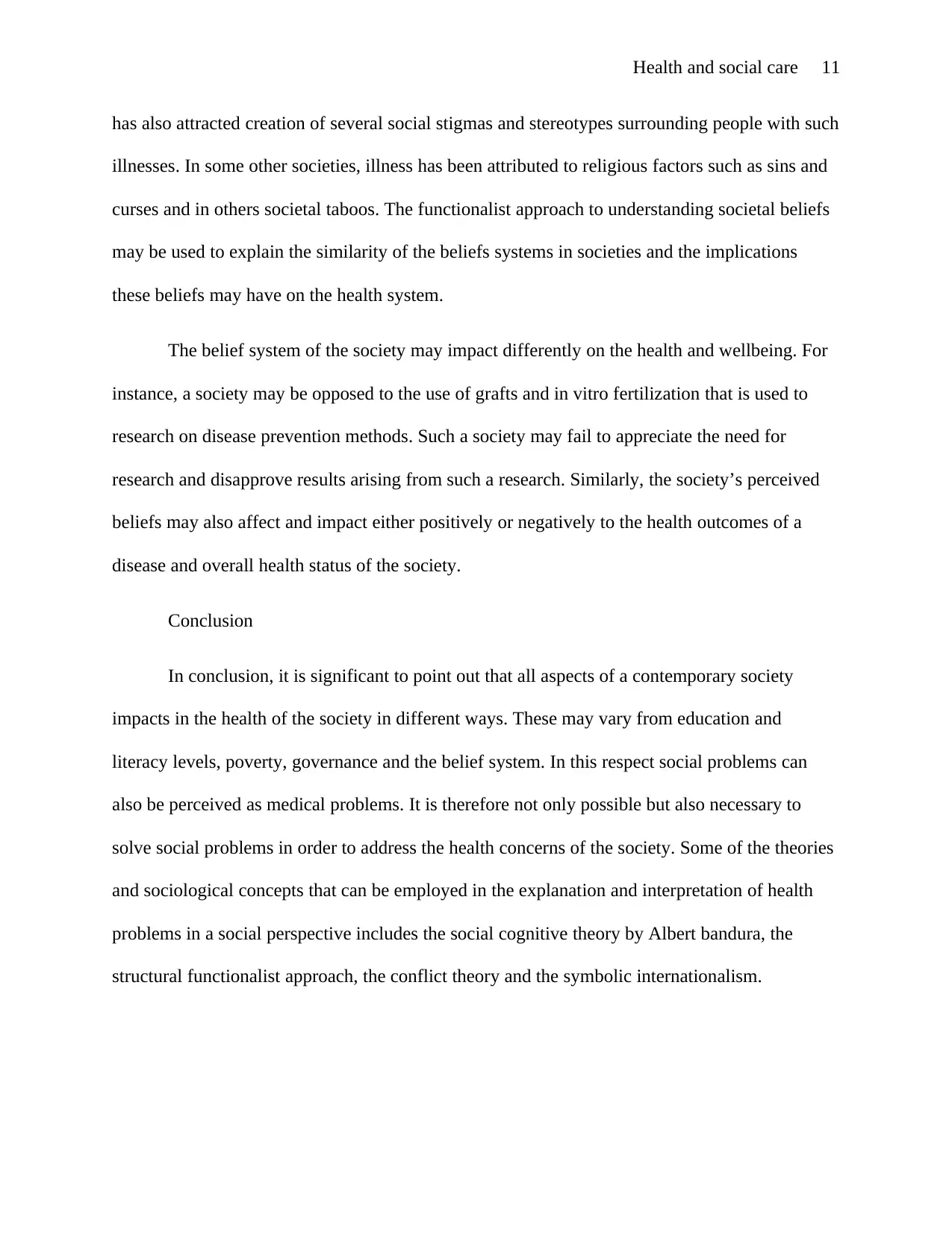
Health and social care 11
has also attracted creation of several social stigmas and stereotypes surrounding people with such
illnesses. In some other societies, illness has been attributed to religious factors such as sins and
curses and in others societal taboos. The functionalist approach to understanding societal beliefs
may be used to explain the similarity of the beliefs systems in societies and the implications
these beliefs may have on the health system.
The belief system of the society may impact differently on the health and wellbeing. For
instance, a society may be opposed to the use of grafts and in vitro fertilization that is used to
research on disease prevention methods. Such a society may fail to appreciate the need for
research and disapprove results arising from such a research. Similarly, the society’s perceived
beliefs may also affect and impact either positively or negatively to the health outcomes of a
disease and overall health status of the society.
Conclusion
In conclusion, it is significant to point out that all aspects of a contemporary society
impacts in the health of the society in different ways. These may vary from education and
literacy levels, poverty, governance and the belief system. In this respect social problems can
also be perceived as medical problems. It is therefore not only possible but also necessary to
solve social problems in order to address the health concerns of the society. Some of the theories
and sociological concepts that can be employed in the explanation and interpretation of health
problems in a social perspective includes the social cognitive theory by Albert bandura, the
structural functionalist approach, the conflict theory and the symbolic internationalism.
has also attracted creation of several social stigmas and stereotypes surrounding people with such
illnesses. In some other societies, illness has been attributed to religious factors such as sins and
curses and in others societal taboos. The functionalist approach to understanding societal beliefs
may be used to explain the similarity of the beliefs systems in societies and the implications
these beliefs may have on the health system.
The belief system of the society may impact differently on the health and wellbeing. For
instance, a society may be opposed to the use of grafts and in vitro fertilization that is used to
research on disease prevention methods. Such a society may fail to appreciate the need for
research and disapprove results arising from such a research. Similarly, the society’s perceived
beliefs may also affect and impact either positively or negatively to the health outcomes of a
disease and overall health status of the society.
Conclusion
In conclusion, it is significant to point out that all aspects of a contemporary society
impacts in the health of the society in different ways. These may vary from education and
literacy levels, poverty, governance and the belief system. In this respect social problems can
also be perceived as medical problems. It is therefore not only possible but also necessary to
solve social problems in order to address the health concerns of the society. Some of the theories
and sociological concepts that can be employed in the explanation and interpretation of health
problems in a social perspective includes the social cognitive theory by Albert bandura, the
structural functionalist approach, the conflict theory and the symbolic internationalism.
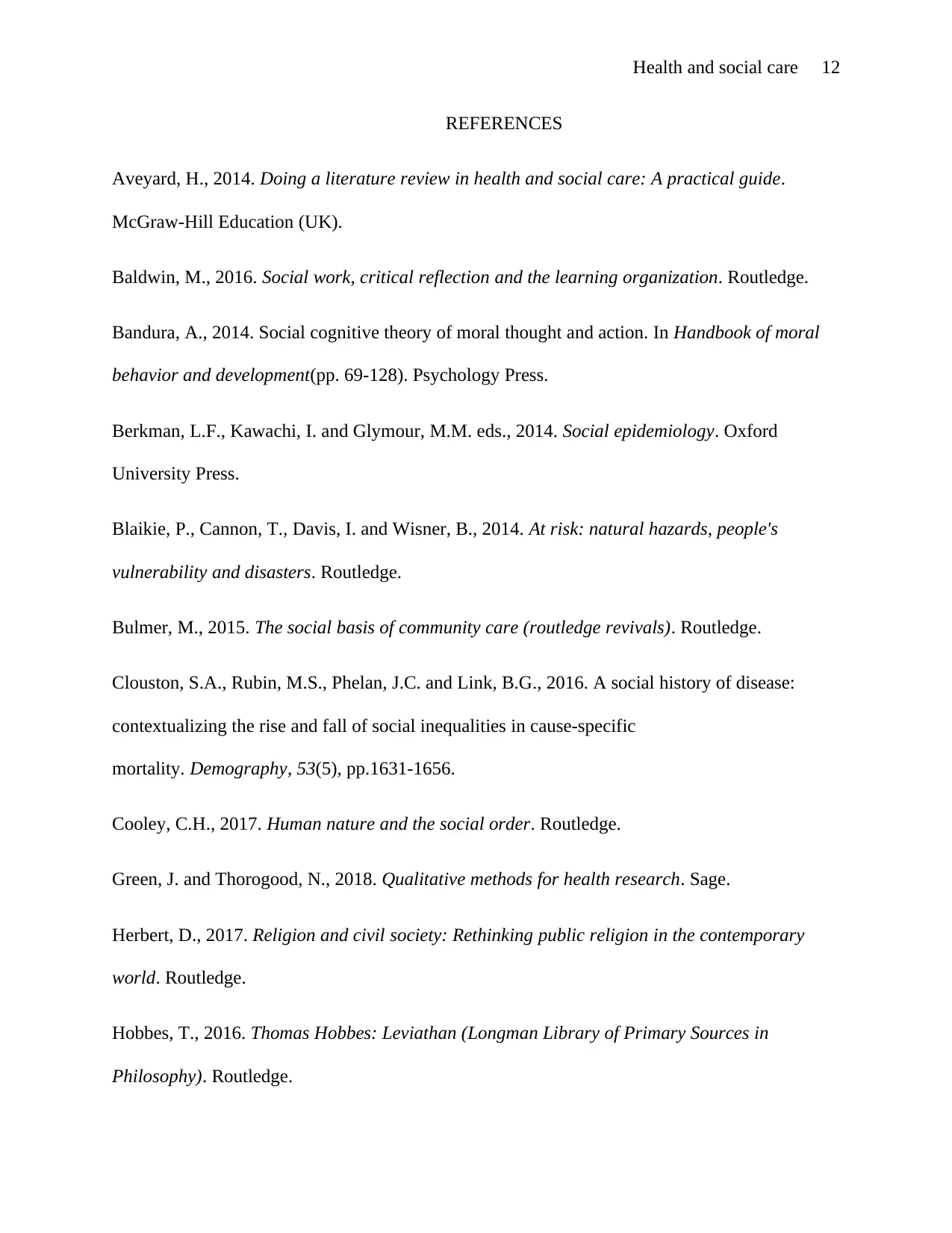
Health and social care 12
REFERENCES
Aveyard, H., 2014. Doing a literature review in health and social care: A practical guide.
McGraw-Hill Education (UK).
Baldwin, M., 2016. Social work, critical reflection and the learning organization. Routledge.
Bandura, A., 2014. Social cognitive theory of moral thought and action. In Handbook of moral
behavior and development(pp. 69-128). Psychology Press.
Berkman, L.F., Kawachi, I. and Glymour, M.M. eds., 2014. Social epidemiology. Oxford
University Press.
Blaikie, P., Cannon, T., Davis, I. and Wisner, B., 2014. At risk: natural hazards, people's
vulnerability and disasters. Routledge.
Bulmer, M., 2015. The social basis of community care (routledge revivals). Routledge.
Clouston, S.A., Rubin, M.S., Phelan, J.C. and Link, B.G., 2016. A social history of disease:
contextualizing the rise and fall of social inequalities in cause-specific
mortality. Demography, 53(5), pp.1631-1656.
Cooley, C.H., 2017. Human nature and the social order. Routledge.
Green, J. and Thorogood, N., 2018. Qualitative methods for health research. Sage.
Herbert, D., 2017. Religion and civil society: Rethinking public religion in the contemporary
world. Routledge.
Hobbes, T., 2016. Thomas Hobbes: Leviathan (Longman Library of Primary Sources in
Philosophy). Routledge.
REFERENCES
Aveyard, H., 2014. Doing a literature review in health and social care: A practical guide.
McGraw-Hill Education (UK).
Baldwin, M., 2016. Social work, critical reflection and the learning organization. Routledge.
Bandura, A., 2014. Social cognitive theory of moral thought and action. In Handbook of moral
behavior and development(pp. 69-128). Psychology Press.
Berkman, L.F., Kawachi, I. and Glymour, M.M. eds., 2014. Social epidemiology. Oxford
University Press.
Blaikie, P., Cannon, T., Davis, I. and Wisner, B., 2014. At risk: natural hazards, people's
vulnerability and disasters. Routledge.
Bulmer, M., 2015. The social basis of community care (routledge revivals). Routledge.
Clouston, S.A., Rubin, M.S., Phelan, J.C. and Link, B.G., 2016. A social history of disease:
contextualizing the rise and fall of social inequalities in cause-specific
mortality. Demography, 53(5), pp.1631-1656.
Cooley, C.H., 2017. Human nature and the social order. Routledge.
Green, J. and Thorogood, N., 2018. Qualitative methods for health research. Sage.
Herbert, D., 2017. Religion and civil society: Rethinking public religion in the contemporary
world. Routledge.
Hobbes, T., 2016. Thomas Hobbes: Leviathan (Longman Library of Primary Sources in
Philosophy). Routledge.
⊘ This is a preview!⊘
Do you want full access?
Subscribe today to unlock all pages.

Trusted by 1+ million students worldwide
1 out of 13
Related Documents
Your All-in-One AI-Powered Toolkit for Academic Success.
+13062052269
info@desklib.com
Available 24*7 on WhatsApp / Email
![[object Object]](/_next/static/media/star-bottom.7253800d.svg)
Unlock your academic potential
Copyright © 2020–2025 A2Z Services. All Rights Reserved. Developed and managed by ZUCOL.




